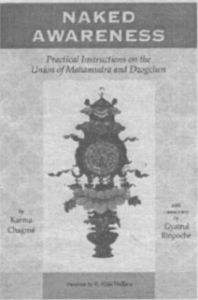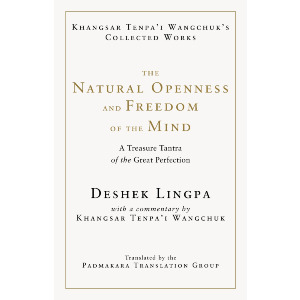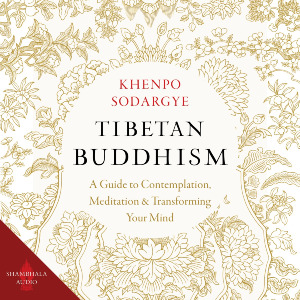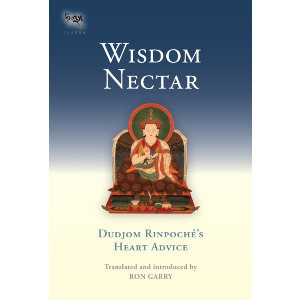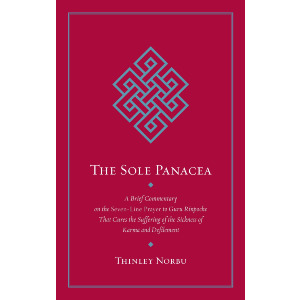The following is an excerpt from
Naked Awareness
By Karma Chagme
With Commentaries by Gyatrul Rinpoche
Translated by B. Alan Wallace
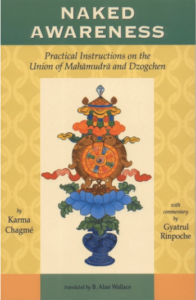
$34.95 - Paperback
| The following article is from the Spring, 1950 issue of the Snow Lion Newsletter and is for historical reference only. You can see this in context of the original newsletter here. |
The Union of Mahamudra and Dzogchen, by the 17th century adept Karma Chagme, is widely regarded as an unusually elegant synthesis of the leading Tibetan approaches to Buddhist meditation. Students and practitioners of meditation will be especially grateful to the Venerable Gyatrul Rinpoche and his translator B. Alan Wallace for these ample and lucid elaborations of these instructions as they are traditionally taught.—Matthew Kapstein
The following is an excerpt from the book. Gyatrul Rinpoche's commentary is indicated by two hyphens (--) at the beginning and the end of each section to distinguish it from Karma Chagme's original text.
The Four Stages of Yoga
Homage to Avalokitesvara!
In accordance with the sutras, tantras, and the teachings of the siddhas, I shall explain how to progress along the grounds and paths by meditating on these profound practical instructions of Avalokitesvara. Both the ten grounds and five paths of the sutra tradition as well as the four stages of yoga of the mantra tradition constitute the grounds and paths of the Sutra[yana] and Mantra[yana]; so it is difficult to fit them together. Likewise, it is also hard to relate them to the four visions of the Great Perfection, for each of these paths is distinct.
-- Here is a brief overview of the essential nature of the Four Yogas. The defining characteristic of the first yoga, single-pointedness, is recognizing the nature of your own mind. Further, you realize that appearances are none other than the nature of your own mind, and that nature is spacelike emptiness. Freedom from conceptual elaboration, the second yoga, entails recognizing that all appearances are adventitious; you realize that the very nature of the mind is empty and free from conceptual elaboration. Thirdly, in the yoga of the one taste, you recognize that samsara and nirvana are of the same nature, which is the key to attaining enlightenment. In the fourth yoga, the yoga of non-meditation, you recognize that the whole of samsara and nirvana is primordially unborn, ungrounded, and unceasing. The very duality of subjects and objects is primordially ungrounded and of one nature the dharmakaya. Many points discussed in the fourth yoga pertain equally to the Breakthrough and Leap-over phases of Dzogchen practice.
While we are encouraged to first study and practice the Sutrayana and then enter the Mantrayana, it is difficult to understand the Four Yogas of Mantrayana in relationship to the five paths and ten grounds of the Sutrayana. Likewise, it is difficult to relate the grounds and paths of the Sutrayana and the Four Yogas of the Mahamudra tradition to the four visions of Dzogchen.
Of the Four Yogas of the Mahamudra, two single-pointedness and freedom from conceptual elaboration are discussed at length in this chapter, and among Tibetan Buddhist contemplatives, a fair number have gained genuine experience in these two stages. The yogas of the one taste and non-meditation are extremely advanced stages of meditation, and for the sake of simplicity the author deals much more briefly with these in this text. --
Zhang Rinpoche says:
Mahamudra is established as one,
But fools become confused by trying to figure out the grounds and paths.
He was referring to simultaneous individuals and those on the stage of the Leap-over. Gradual individuals practice in accordance with the ten grounds and five paths, so Naropa says, First experience single-pointedness. The Primary Words of the Great Instructions states, Abide in the reality of single-pointed, indivisible quiescence and insight. The meaning is that single-pointedness entails abiding in the spacelike reality of emptiness and luminosity. At that time, you realize the essential nature of meditation as spacelike emptiness and luminosity, but the insight of certain knowledge has not arisen from that spacelike emptiness and luminosity. Thus, with single-pointedness you pointlessly wander about in darkness. At that time, your subsequent [post-meditative] consciousness reifies phenomena by grasping onto them as ordinary and real. Hence, even though you ascertain empty luminosity during meditative equipoise, your subsequent consciousness becomes confused concerning ordinary things, so there is the stain of grasping onto them as real, and the stains of karma are not purified.
If you are not mindful, you disengage from meditation, which brings about separation; and even if you are mindful, the essential nature is not seen [during the post-meditative state], so there is no attainment. You have not dispensed with superimpositions upon experience, and you still have the sense of an object and agent of meditation; so this is a time of meditation in which the mind itself is reified. The form aggregate and the five avenues of consciousness are purified. They are cognized as naturally empty, ungrounded in an essential nature. Since you are inevitably subject to grasping, your experiential realizations are stained. In terms of the appearances to your limpid awareness, you precisely discern subtle and gross causality; but because this is grasped as being real, causality is reified. When you are undistracted, you are in meditative equipoise, and when you are distracted, you are in the post-meditative state.
At this time you disengage from characteristics, and you chiefly cultivate quiescence in a state that is free of the intellect. You know your own essential nature of empty luminosity.
-- Rather than focusing on Mahamudra as one state, some people become confused by obsessively concerning themselves with the grounds and paths. Simultaneous individuals need not worry about following the gradual path of the ten grounds and five paths, because due to their past accumulation of great merit and purification, their practice is utterly simple and instantaneous. Those who have progressed through practice to the Leap-over stage of Dzogchen also do not need to concern themselves with the ten grounds and five paths. Gradual individuals, in contrast, must practice in accordance with these grounds and paths, proceeding through each of the yanas
Among the Four Yogas, one must first achieve the state of single-pointedness, which entails a union of quiescence and insight, and therefore a high degree of attentional stability. Therefore, the first stage of single pointedness occurs with the accomplishment of quiescence, wherein one single-pointedly attends to one's own awareness, which is primordially unceasing and luminous. This is realized when the mind is free of obscurations. Progressing to a more advanced stage of single-pointedness requires the cultivation of insight. Practicing without genuine quiescence or insight, while just being spaced out, is pointless. There are, of course, many methods to cultivate quiescence such as attending to an object or simply meditating on the nature of awareness but each method eventually culminates in the indivisibility of quiescence and insight, which has the spacious quality of both emptiness and luminosity. That constitutes the nature of the first of the four stages of yoga single-pointedness. This is comparable to the Hinayana realization of identitylessness with traces of grasping still present, so this realization is not considered to be perfect, for the thought, This is identitylessness, still remains. This state is analogous to the sun that has not completely risen over the horizon or a flower not yet in full bloom. You realize the essential nature of the meditative state, but you have not gained the certain knowledge that arises from spacelike emptiness and luminosity. That is because grasping is still present. After meditation sessions, your old habit of grasping onto the tangible, or substantial, existence of phenomena arises once again. As you sit in meditation, you may have a sense of the emptiness of phenomena, but if someone knocks on the door, your attention immediately becomes riveted on that, and then grasping has occurred. This is what is meant by the term reify grasping onto phenomena as being substantial, or inherently existent.
Due to grasping, purification is not complete. You have gained realization of the various fields of consciousness and so forth as being empty, ungrounded in an essential nature, and you have a clear understanding of both subtle and gross causality, but you still grasp onto it as being real, rather than as dreamlike or illusory. Since you grasp onto the phenomena involved in causal relationships as being real, the causal relationships themselves are reified as well. --
Dagpo Rinpoche says, The yoga of single-pointedness is luminous and unceasing, and that is momentary consciousness. Saraha says:
By holding firm without
mindfulness, there is unceasing emptiness.
If consciousness is left in its own mode, there will be stability.
And:
If you remain there, a sense of bliss will occur.
Experiencing the appearances of tilings as empty
Is like recognizing water even though it appears as ice.
-- Momentary consciousness is the interlude after thoughts of the past have vanished and before thoughts of the future have yet arisen. In this phase of practice, thoughts of the three timesof the past, present, or futureare not present. While in meditative equipoise, you are completely free of intellectual constructs or mental fabrications. In this state a sense of bliss may occur, and if you think, I like this. This feels good, you only perpetuate your own cyclic existence. Among the three experiences of bliss, clarity, and nonconceptuality, not grasping onto bliss leads to the realization of the nirmanakaya; not grasping onto clarity leads to the sambhogakaya; and not grasping onto nonconceptuality leads to the attainment of the dharmakaya. --
The mental isolation discussed by Nagarjuna in The Five Stages, the yoga of spontaneous presence taught by Lawapa, the yoga of the experience of samadhi taught by Nawaripa, cutting off superimpositions as explained by Maitripa, the yoga of identitylessness in The Descent into Lanka Sutra, the meditative stabilization practiced by the childish, the dew-drops of The Six Dharmas, and the meaning of the vase empowerment are all said to be synonymous.
The Great Instructions states:
In the medium stage of single-pointedness, you occasionally enter into samadhi even when you are not meditating, and stability comes when you are meditating. In the limpidity of training in the samadhi of bliss, clarity, and nonconceptuality you can display numerous kinds of tainted extrasensory perception and paranormal abilities. In that state ideation arises less than before, and whatever arises proceeds in its own limpidity. Afterwards, whenever you are mindful of spacious appearances that are imbued with a sense of empty luminosity, at times this arises as meditation, and at times it arises more substantially. Dreams occur less frequently than before. At times you have such an experience, and at times you do not, and you become fascinated with this meditation.
-- In the medium stage of the yoga of single-pointedness, the stability of your samadhi may arise naturally even when you are not in formal meditation. But you cannot become complacent and stop applying yourself to rigorous meditation at this point. If so, you will be carried right back into samsara because your many habitual propensities have not been dispelled, and they will simply re-emerge. The qualities of bliss, clarity, and non-conceptuality are in fact of one nature; they are primordially of the very nature of your own awareness. You do not develop or attain them by means of this practice. Rather through the stages of this practice these intrinsic qualities become more and more manifest.
One result of this practice is the achievement of extrasensory perception and paranormal abilities, but because they are not completely free of mental afflictions or obscurations, they are said to be tainted. It is inappropriate and even harmful to respond to these abilities with attachment or amazement, because that throws you off the path. However, the untainted extrasensory perception and paranormal abilities of a perfectly awakened being are certainly worthy of aspiration. Being both taintless and ultimate, they are of the nature of perfect enlightenment.
These paranormal abilities, like buried treasures, arise from time to time, and many people are profoundly misled by them, whether they achieve them themselves or witness them in others. Being fascinated with them only indicates an improper relationship with one's spiritual mentor and a lack of understanding of the stages of practice.
These days, more and more people are drawn to Dzogchen, and many try to practice and even teach it without establishing a sufficient foundation by completing the preliminary practices. These people are like little children who do whatever they like at the dinner table, stuffing food in their mouths whatever and however much they want. We' can't practice everything at once any more than a child can eat everything on the table. If parents are conscientious, they give only the amount of food that their child can properly digest; and if the child listens to the parents, he or she will take only what is given. In this way the child will be well nourished, grow well, and be free of illness. We should follow the same model in our practice of Dharma. If you don't, but rather leap into the more advanced stages of practice with an insufficient foundation, it will drive you crazy.
Recently, when I was interviewed about Buddhism in America, I was asked whether I thought Buddhism was flourishing and asked about my view on the relation between Buddhist teachers and students. In the West, there is a tradition of reading and relying on books rather than an actual teacher. It is quite common for people to hold a book up as the final authority. This tendency occurs in school systems and the government as well. If an issue is in debate, someone will point to a book as a final authority. In certain cases this is very helpful, but if something goes wrong in your practice and you experience ill effects, would it be proper to blame some author? Generally speaking, it is important to rely on a qualified spiritual mentor and not simply on a book. You need to listen to the spiritual mentor and then put his or her advice into practice. Both the spiritual teacher and the student need to have two eyes the eye of wisdom and the eye of skillful means.
In this stage of single-pointedness, all that arises to the mind appears in its own luminosity, displaying no essence, or substantial nature. The contents of the mind arise like small clouds in the sky or like ripples on the ocean's surface. Fluctuations still occur, and by the power of previous habituation, phenomena appear concretely at times. You have fewer, more lucid dreams, and your interest in meditation will become stronger. In previous stages you tended to become easily tired, now you yearn to practice.


